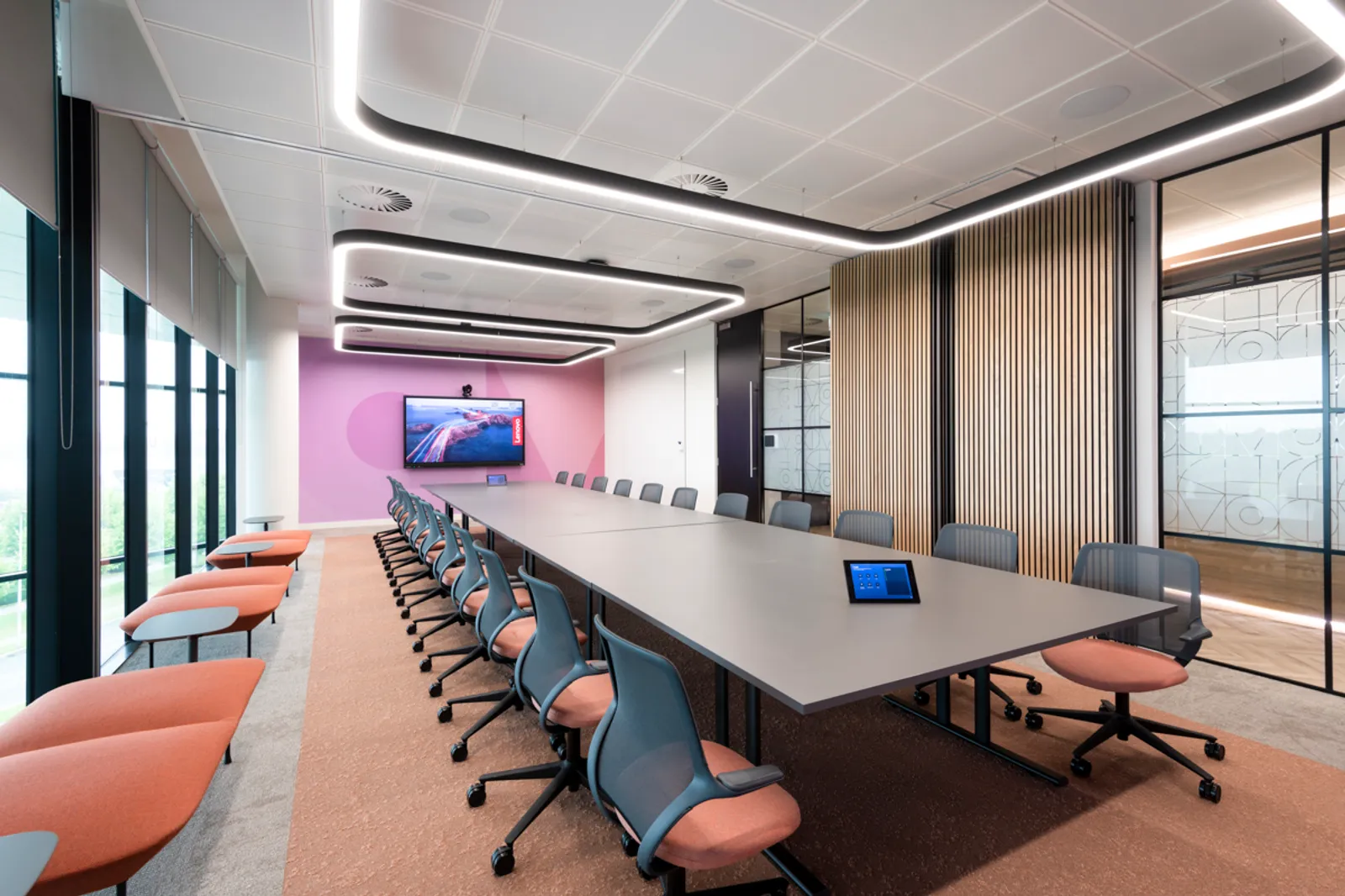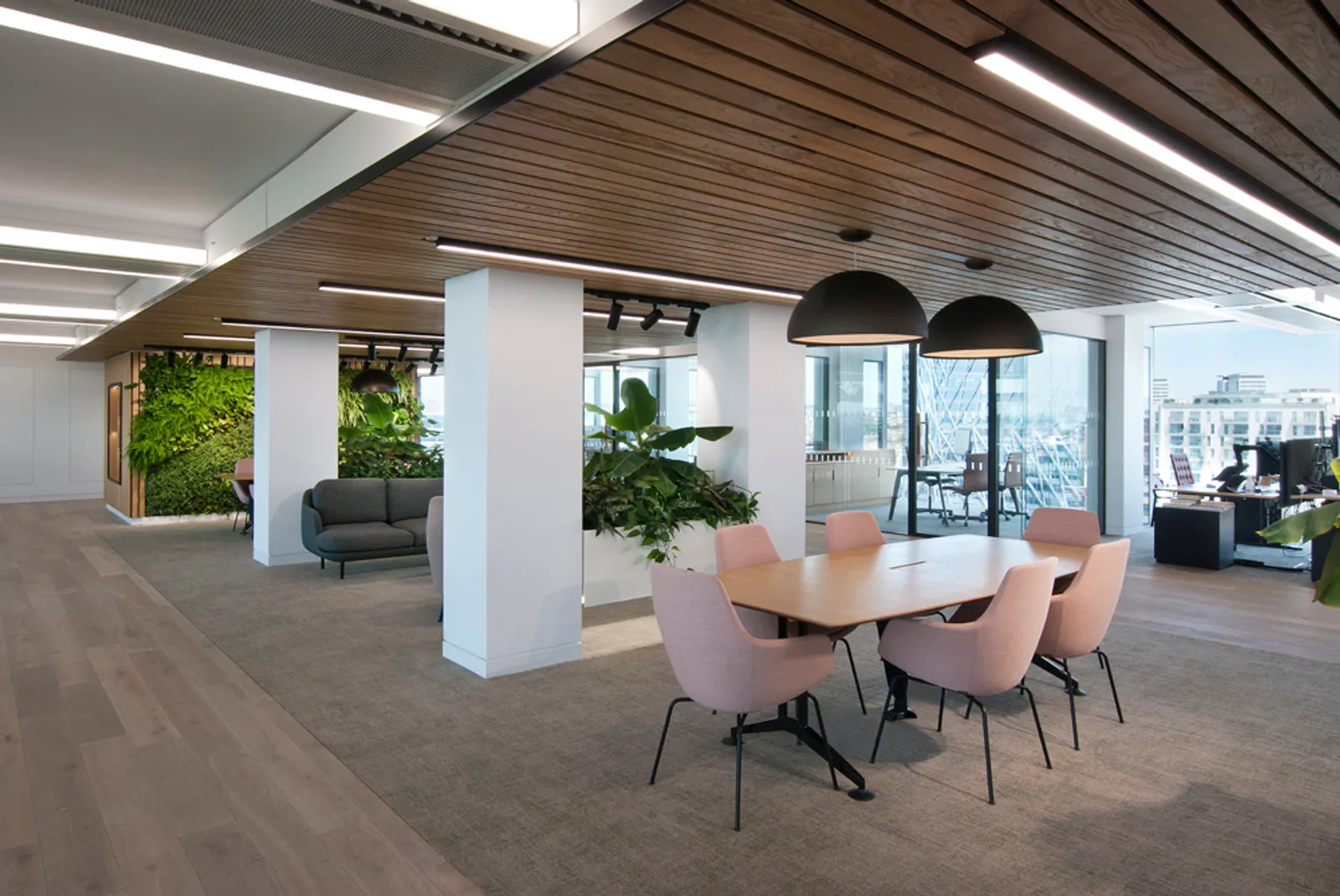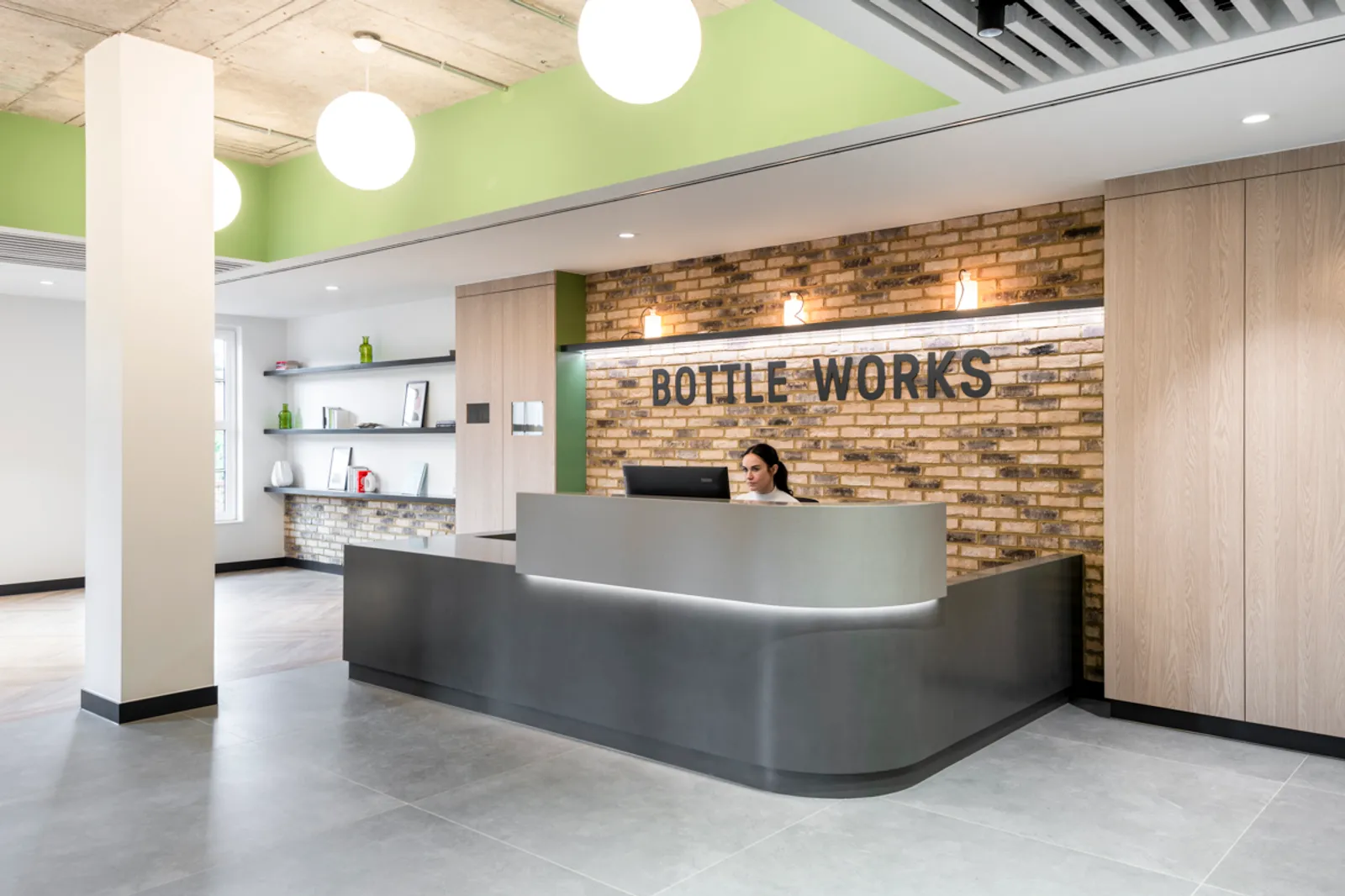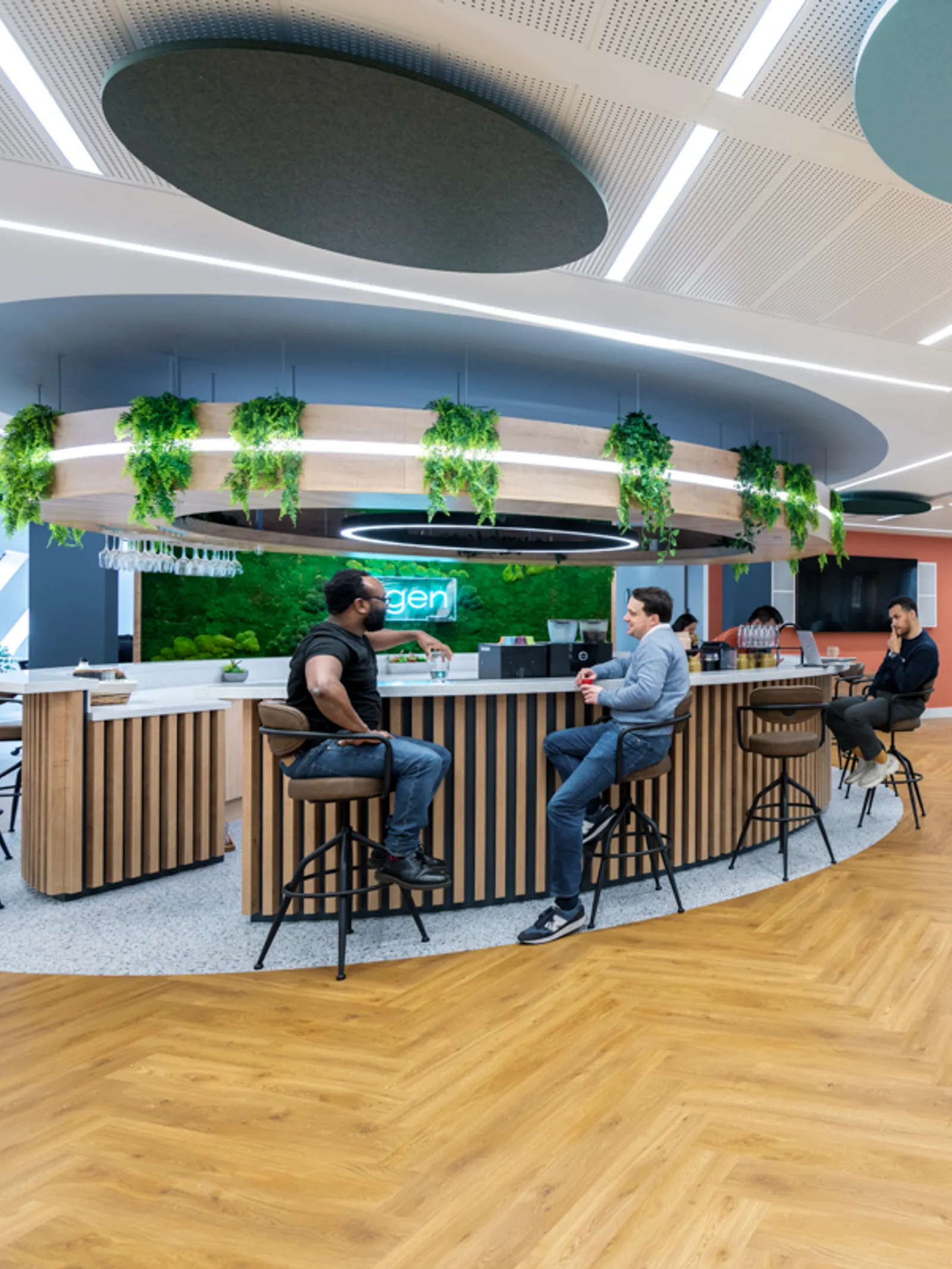A strategic commercial property refurbishment can benefit both landlords and investors by increasing asset value, securing high-quality tenants, and future-proofing their portfolios. Investing resources into transforming a dated or ill-equipped property into a modern, efficient, and human-centric workplace creates a workspace that's not only just 'fit for purpose,' but a destination that satisfies the demands of today's leading businesses.
The essential benefits include an immediate uplift in property valuation and potential rental income, enhanced tenant attraction and retention in what is set to be an increasingly competitive market, and significant improvements in energy efficiency and sustainability credentials that can create cost savings and align with ESG goals.

Why commercial property refurbishment is a strategic investment
The present-day commercial real estate market is fast-paced and dynamic. The very definition of an 'office' has been redefined, and expectations from employees have shifted. No longer just a place to work, the modern workplace has become a strategic tool in its own right, where successful, forward-thinking businesses foster a culture, drive collaboration, and attract the brightest talent.
This paradigm shift has created a distinct "flight to quality," where tenants are no longer looking for a space that is merely functional but also one that is experiential, sustainable, future-proofed, and aligned with their corporate values.
Landlords and property investors are thereby presented with both a challenge and an opportunity. Those who choose to ignore this shift and who refuse to invest in older, less efficient buildings are likely to find themselves with longer vacant periods and quickly diminishing returns.
Conversely, those who have the foresight to appreciate future benefits and undertake thoughtful, well-executed commercial refurbishments now will soon discover that it is no longer a simple maintenance expenditure; it is a proactive, value-generating investment.
By reimagining and upgrading a commercial space, it transforms from a mere commodity into a premium product. In this article, we will further investigate the compelling and multifaceted benefits of commercial refurbishment, exploring how it can serve as a means to achieve steady, long-term profitability.
1. Maximise asset value and future-proof your investment
Undoubtedly, the most compelling reason to refurbish your commercial property is the direct financial return you will see. The financial benefit is twofold. A refurbished property benefits from premium rental rates, resulting in better long-term income potential. The capital appreciation from the property itself is also higher.
2. Directly increasing your commercial property's capital and rental value
A refurbished, Grade A office space consistently commands higher valuations and rental rates than its Grade B or C counterparts. Upgrading the overall quality, amenities, and building performance directly translates to a higher price per square foot. Recent market analysis from property consultants Savills, suggests that the rental premium for prime, newly refurbished office space in major cities can be substantial, as businesses are willing to pay for environments that are tailored to their operational and strategic goals.
A full refurbishment of an older property will address these core elements that valuers and tenants covet and will assess when choosing the ideal property for their business needs:
Mechanical & Electrical (M&E) Systems: Upgrading HVAC, electrical wiring, and plumbing can create important energy efficiencies but also de-risk the building for potential occupiers.
Building Fabric: Refreshing the façade, windows, insulation, and roofing will enhance curb appeal and improve thermal performance.
Interior Finishes: Quality furnishings and finishes that are aesthetically pleasing and contemporary will emulate an immediate impression of value and care.
Investing in your property gives a clear signal that it is a prime asset and deserves the attention of higher-calibre investors who are willing to pay its enhanced capital value.

3. Future-proofing against market volatility and obsolescence
The world of work is in constant flux, and savvy building owners will be willing to adapt to the changing times. Even buildings that were upgraded within the last 10 years may no longer support the kind of technology that today's tech-driven businesses rely on. A carefully considered refurbishment can secure your asset by providing businesses with the infrastructure they need to operate efficiently and embedding flexibility and adaptability into its very core.
To do this, refurbishments will consider:
Incorporating flexible layouts
Catering to a diverse workforce with differing (and often competing) needs will ensure your property appeals to different business types. Moveable partitions, diverse work settings (e.g., quiet zones, collaboration hubs, project rooms), and adaptable furniture systems are all features of the most sought-after offices.
Integrating smart technology
Implementing a robust digital infrastructure is a crucial part of any contemporary office refurbishment. High-speed connectivity to integrated AV systems and smart building controls for lighting and climate have shifted from 'nice-to-have,' to a baseline expectation.
Adapting to new workstyles
A refurbishment can introduce features that support a hybrid workforce, such as high-tech meeting rooms for seamless video conferencing and bookable hot-desking systems.
By anticipating and accommodating these trends, you ensure your property remains relevant and desirable for years to come, protecting its value against market shifts and preventing obsolescence.

4. Attracting and retaining premium occupiers
The quality of your space is something that you can leverage and market. Competition for the highest-calibre tenants is fierce, and a standout office refurbishment can make a significant difference when it comes to attracting and retaining long-term, stable, and highly profitable tenancies. A recently refurbished office will have fewer void periods, attract premium rental rates and help to build a successful property portfolio you can rely on.
Today's most desirable tenants are not just looking for a lease; they are looking for a partner in their success. A workplace is an extension of a business's brand and directly reflects its employee value proposition. Buildings that offer a first-rate experience will attract these desirable businesses, ones that are often willing to relocate for the right space.
A commercial refurbishment enables you to compete at the highest level by offering the features that top-tier companies now demand:
Exceptional first impressions
When it comes to staying competitive, first impressions count. Client-facing businesses in particular demand sleek and welcoming reception areas, modern, comfortable common areas, and high-end finishes that create an immediate sense of prestige.
Amenity-rich environments
On-site facilities that create a standout building include coffee bars, fitness centres, secure cycle storage, shower facilities, and rooftop terraces. These powerful differentiators help businesses attract top talent.
A sense of community
Well-designed communal spaces can foster a building-wide community, adding value beyond the demised office space. By delivering a product that aligns with the aspirations of premium businesses, you position your property at the top of their shortlist.
5. Reducing voids and increasing lease longevity
A property that stands vacant costs the owner more than just the loss of rent; it includes business rates, security, and expensive marketing costs for finding a new tenant. Savvy building owners are proactive when it comes to minimising these void periods - they achieve this by creating an environment where tenants want to stay.
Tenant satisfaction is directly linked to the quality of their physical workspace. A refurbishment focusing on the user experience, prioritising comfort, functionality, and aesthetics, will have a knock-on effect. Happier, more productive occupants are more likely to renew their leases, and in doing so, provide landlords with a stable, consistent income that eliminates the associated costs that come with constantly trying to re-let the space.
6. Enhancing wellbeing and creating a destination workplace
Progressive landlords understand that they are no longer in the business of leasing square footage; they are in the business of providing human-centric environments. The most attractive companies now focus on employee wellbeing and integrate plans to ensure that employees feel valued and cared for. The link between employee wellbeing and productivity, turnover and satisfaction is undeniable, so businesses actively search for buildings that offer a framework to support this.
The Tangible Impact of Wellbeing-Led Design
A refurbishment provides a fresh opportunity to make wellbeing part of the building's fabric - this extends beyond aesthetics, but rather is a strategic and considered move to ensure that employee wellbeing is front and centre.
Biophilic Design: The practice of connecting people with nature within the built environment has been proven to enhance wellbeing. A study by Human Spaces found that office workers in environments with natural elements reported a 15% higher level of wellbeing, were 6% more productive, and 15% more creative. Refurbishments can incorporate this through the use of living walls, natural materials, abundant planting, and maximising natural light.
Improved Air Quality and Thermal Comfort: Upgrading ventilation systems (HVAC) to provide fresh, filtered air and giving tenants greater control over their local temperature can have a profound impact on health, comfort, and concentration.
Acoustic Comfort: In an era of open-plan layouts and video calls, managing noise is crucial. A refurbishment can address acoustics through the use of high-performance ceiling tiles, sound-absorbing panels, and the strategic zoning of quiet and collaborative areas.

7. The Sustainability Imperative: ESG, Efficiency, and Compliance
Environmental, Social, and Governance (ESG) criteria are no longer a concern that sits on the periphery of corporate strategy; instead, it has become a critical pillar that influences decision-making on every level and can have a direct impact on commercial viability.
Meeting Tenant ESG Goals and Achieving Certification
Large corporate tenants, in particular, have stringent ESG targets and will no longer even consider properties that could negatively impact their sustainability reporting. A commercial property refurbishment is the fastest and most effective way to enhance a building's environmental performance and identify areas for improvement.
A thoughtful refurbishment could incorporate targets for prestigious certifications, such as BREEAM (Building Research Establishment Environmental Assessment Method), which are viewed as a hallmark of a high-quality, sustainable asset. A "Very Good" or "Excellent" BREEAM rating can significantly enhance a property's appeal, as ESG-conscious tenants battle to secure it and future-proof against stricter environmental regulations, should they emerge.
Driving Down Operational Costs and Ensuring Compliance
Sustainability is simply a smart business move. Energy-efficient technologies will drastically reduce the building's operational costs. The most savvy property owners will pass this saving on to tenants to make the service charge more competitive.
Typical upgrades include:
LED Lighting and Smart Controls: Sensor-based lighting systems can reduce electricity consumption by over 50%.
High-Performance Glazing and Insulation: Minimising heat loss and gain reduces the load on heating and cooling systems.
Efficient HVAC and Plant: Modern M&E systems are significantly more energy-efficient than their older counterparts.
UK regulations are expected to tighten. Minimum Energy Efficiency Standards (MEES) already prohibit the letting of commercial properties with an Energy Performance Certificate (EPC) rating below 'E'. If property owners wish to avoid periods of downtime, they would be wise to get ahead; therefore, a refurbishment may be considered essential to ensure compliance, avoid penalties, and maintain the value of their asset.
Make the strategic move and refurbish your commercial property with Area today
Investing in a commercial property refurbishment is a strategic move that can convert an older, undesirable property into a high-performing, highly sought-after asset. By responding to the demands of the modern property market in this way, landlords can reap numerous benefits that span the entire investment lifecycle.
From increasing rental value and boosting the property's value to attracting and retaining top tenants, enhancing the human experience, and preparing for more stringent sustainability goals, refurbishment is the pathway that unlocks the full potential of your commercial asset. In a world where quality and experience are paramount, it is the most reliable route to securing long-term success and profitability.
Ready to explore how a strategic refurbishment can transform your commercial property?
Contact the workplace experts at Area to start the conversation.
Frequently Asked Questions (FAQs)
What is the typical ROI on a commercial property refurbishment?
The Return on Investment (ROI) varies significantly based on the project's scope, location, and initial condition of the property. However, a strategic refurbishment that elevates a building's EPC rating, improves amenities, and enhances its aesthetic appeal typically leads to a significant uplift in rental income and capital valuation, often providing a return that far outweighs the initial capital outlay.
How long does a commercial refurbishment take?
The timeline depends on the scale and complexity of the project. A light cosmetic refresh might take a few weeks, while a comprehensive structural and M&E overhaul could take several months. At Area, we work with clients to establish a clear project timeline from the outset, ensuring minimal disruption and a predictable completion date.
Can you refurbish an office space while it is still occupied?
Yes. This is known as a phased refurbishment. The project is broken down into stages, allowing work to be completed in one area of the building while tenants continue to operate in another. This requires meticulous planning, clear communication, and a focus on health and safety to minimise disruption to the occupants.
What is the difference between a commercial fit out and a refurbishment?
A refurbishment (often called a 'Cat A' fit out) involves upgrading the base building for the landlord to make it ready for letting. This includes M&E systems, common areas like lobbies and lifts, and general finishes. A fit out (or 'Cat B' fit out) is typically undertaken by the incoming tenant to tailor the space to their specific needs, including installing partitions, meeting rooms, branding, and furniture.
How does a refurbishment improve a building's BREEAM rating?
A refurbishment can impact a BREEAM rating across multiple categories. Upgrading to energy-efficient lighting and HVAC systems improves the 'Energy' score. Using sustainably sourced materials affects the 'Materials' score. Enhancing access to natural light and improving air quality boosts the 'Health and Wellbeing' score. Adding cycle storage and improving access to public transport contributes to the 'Transport' score. A holistic refurbishment strategy is key to achieving a higher rating.




